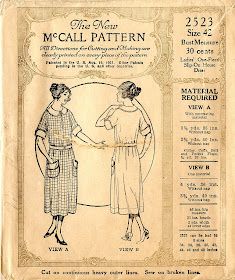

First half of the 1920s.
Made up in a cotton shirting that was on sale for a few dollars a yard, with white pique trimming.
Finished measurements:
Center back length: 51 1/2"
Actual bust measurement: 53"
Actual hip measurement: 55"
Belt finished measurement: 40"
House dresses don't get much simpler than this. You really don't need to spend 30 cents for a pattern. The Lesson II book of Isabel Conover DeNyse's A Complete Course in Dressmaking, Aprons and House Dresses, shows a very similar dress on its cover, and then guides you through making a simple house dress pattern from a blouse pattern.
The only construction instructions on this McCall pattern are on the back of the envelope.
As usual with garments that don't have shoulder seams, a directional print will be upside down on the back unless you add a shoulder seam. You're assumed to know how to make a slashed opening (either bound or faced) and how to attach a collar with a bias facing.
The sides are finished with french seams and the 3" hem is sewn by hand. After I'd finished buttonhole stitching the loop for the button I remembered reading somewhere the tip to make tatted rings to whip on in place; as far as I know this is the only really practical use for tatting.


























